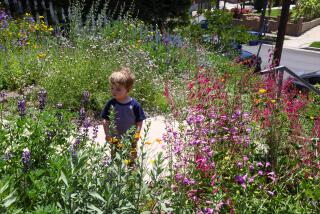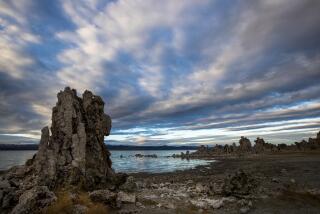Planting the seeds of conservation
- Share via
Ellen Keys knows about drought. She grew up during the Great Depression in Sallisaw, Okla., depicted in the early pages of “The Grapes of Wrath,” John Steinbeck’s epic saga of drought and poverty.
She paid closer attention than most Long Beach residents to the pleas for water conservation issued earlier this year by the city Water Department in the face of the Southern California drought and looming water shortages.
“We had signed up for a new sprinkler system and a new lawn, front and back,” Keys said, “but I read three months ago where this water is getting awfully scarce, and I asked my husband, ‘Do you think we should spend all this money?’ ”
So the couple canceled their order, and Keys, 83, signed up for a free class on low-water gardening held Saturday at Water Department headquarters. She began thinking of a new lawn design for her home near Long Beach Airport that would feature bricks and drought-tolerant plants.
Keys’ instincts proved right.
Three days ago, the Water Department drew statewide attention by issuing the most stringent water-use restrictions of any city in the region. Water experts predict that other cities will soon follow suit. The most talked-about rule will forbid residents to water lawns, plants and gardens more than three times a week -- and even then, only between 6 p.m. and 7 a.m.
Water officials in this waterfront city of 461,000 already were doing research on desalination processes and mailing out notices in water bills, urging residents to curtail showers and change gardening habits. The new rules, which go into effect Friday, are not just short-term measures, they say.
“This is a permanent change, in terms of how we can use water,” said Matthew Lyons, the Water Department’s director of planning and conservation. “This isn’t just about this winter. This is a whole new paradigm.”
The approach was praised Saturday morning by Keys and other residents who attended the department’s 3 1/2 -hour free gardening class.
“I think they should crack down,” said Keys. “It looks pretty dire to me, this shortage of water, and if we get out of water, we can’t live.”
Most of the 30 students had signed up before Thursday’s announcement, but some said they felt more of a sense of urgency because of the new rules.
Bob Spears came to learn about grasses that consume less water.
“I’m intending to move into more drought-tolerant plants,” he said. “I see the necessity. It’s not going to get any better.”
Pat Robertson, 71, took detailed notes about drought-resistant trees and plants that would suit the wide brick planters in the frontyard of her home near Wardlow Park.
Robertson and her husband did away with their lawn 25 years ago to save on water and grass mowing. After she was diagnosed with breast cancer in May 2006, she hired a gardener who planted mostly annuals in the brick planters.
Now, the annuals are fading. After learning Tuesday that she is cancer-free, Robertson is gearing up to design a low-water “plant palette” that may include species that caught her attention at the Saturday class. She likes the looks of an Australian willow tree, as well as salvias.
The class was taught by Tim Wheeler, a horticulturist and consultant to the Metropolitan Water District, who has taught similar seminars in other cities. This year, he is noticing more focus on drought-tolerant gardening practices.
“Just generally across the board, there seems to be more interest,” Wheeler said.
Local plant nurseries report more queries from customers.
At H&H; Nursery in nearby Lakewood in recent months, owner Jeff Shibata has helped a number of Long Beach residents who bring in mailers sent to them by the Water Department with lists of drought-tolerant plants.
Some customers are taken aback, however, by what some call the “weedy” look of some native California plants, Shibata said. They prefer more colorful plants from South Africa, New Zealand and Australia -- such as New Zealand flax and Australian kangaroo paws.
Armstrong Garden Centers, which has a store in east Long Beach, has noticed that some customers can be overwhelmed by the notion of changing to all California natives.
“I prefer to talk about a ‘Mediterranean’ palette,’ ” said Armstrong marketing manager Gary Jones.
He advises drought-conscious gardeners to consider gardening in containers and planting water-hungry species like hydrangeas close to the house, where they can be watered by hand when needed, rather than by wide-ranging sprinkler systems.
The Long Beach Water Department operates under its own charter, and policy is set directly by water commissioners rather than the City Council.
But the city is also taking steps to conserve water.
The city will soon require new developments such as the proposed Lennar condominium project near Seal Beach to conduct water-use assessments in preparing environmental reviews, Suzanne Frick, the city’s planning and building director, said Friday.
The council has approved a separate policy that all new projects that have not received building permits must meet special conservation guidelines, Frick said.
Water-conscious gardening tips can be found at www. bewaterwise.com. The new Long Beach water restrictions are listed on the Water Department website, www.lbwater.org.
--
deborah [email protected]
More to Read
Sign up for Essential California
The most important California stories and recommendations in your inbox every morning.
You may occasionally receive promotional content from the Los Angeles Times.










